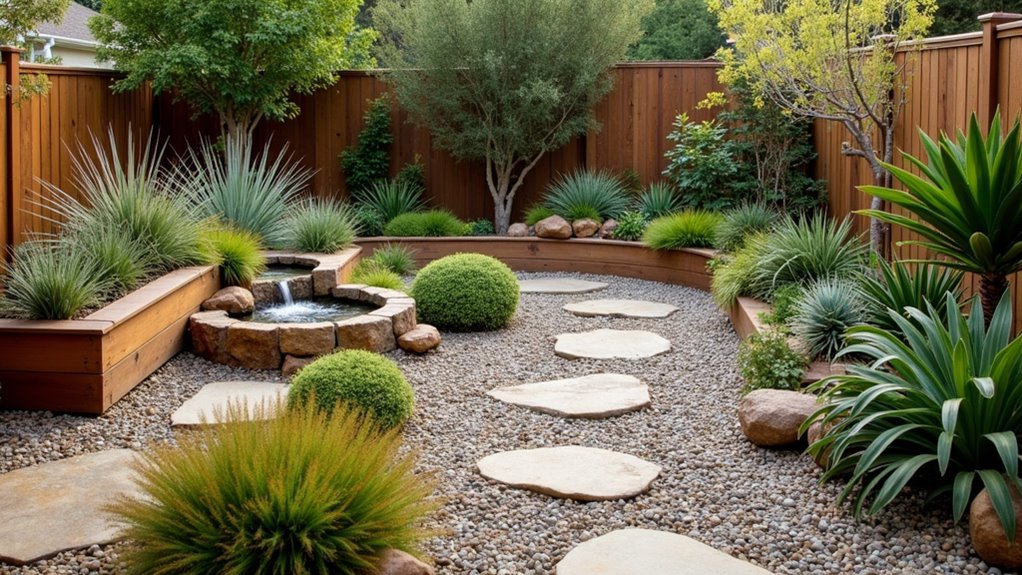Here are some cutting edge zeroscaping ideas to turn our backyards into green havens. By selecting drought tolerant plants and using native plants, we can have beautiful and sustainable landscapes. In addition we have designed rock gardens, installed dry stream beds, and used mulch to retain moisture in our green spaces. Let’s make fire pits and outdoor seating areas with natural materials, add some seasonal color. Come discover how to create a garden that supports biodiversity!
Table of Contents
Key Takeaways
- Select drought-resistant plants like succulents and native wildflowers to minimize water usage and maintenance in your garden.
- Incorporate rain barrels and drip irrigation systems to efficiently collect rainwater and deliver targeted moisture to plants.
- Design low-maintenance flower beds using native perennials that thrive in local conditions, reducing the need for replanting and extensive care.
- Create aesthetically pleasing rock gardens with proper drainage, using decorative stones alongside drought-tolerant plants for a sustainable landscape.
- Utilize ground cover plants like Creeping Thyme and Sedum to prevent soil erosion while enhancing beauty and supporting local ecosystems.
Choosing Drought-Resistant Plants
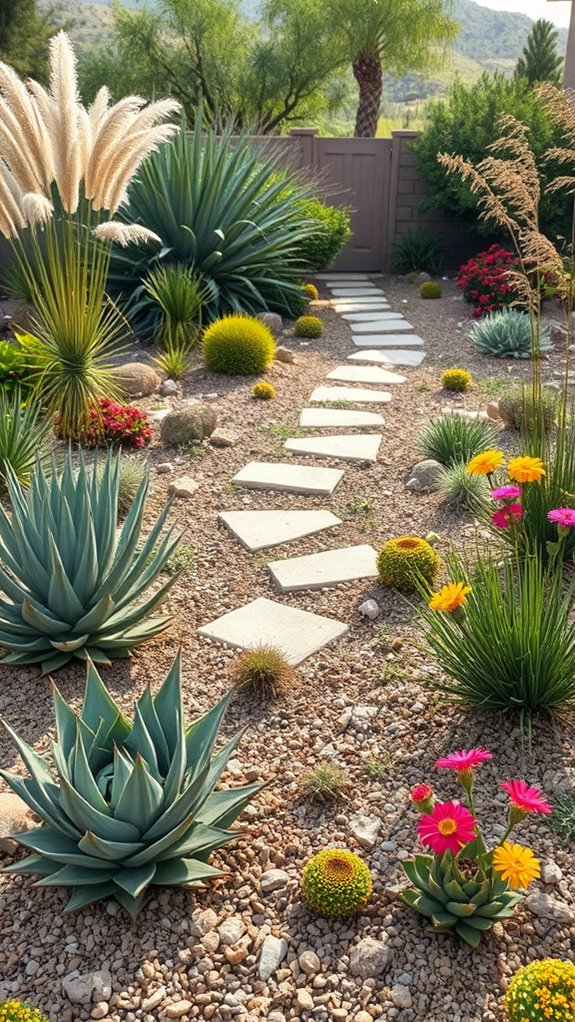
If you’re looking at sustainable backyards, planting drought resistant plants is a must for water conservation and maintenance.
By using drought tolerant varieties, we can create a beautiful landscape, that will do well under dry conditions. These plants are often low water needing once established, perfect for our green gardens.
We should consider alternatives such as lavender, succulents and native wildflowers, which can put on beautiful low-water flowering shows. They are not only lovely to look at, they attract pollinators and contribute to biodiversity.
By selecting these resilient plants we create a lush environment that respects our resources and enhances our outdoor living space.
Lets be innovative with how we garden and make sustainability a priority!
Incorporating Native Species
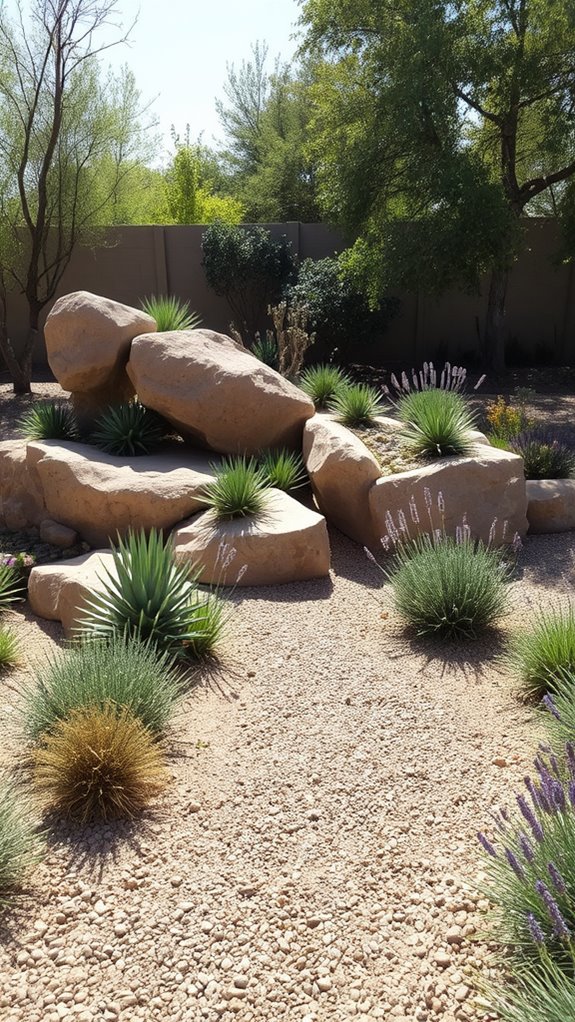
In addition to our choice of drought tolerant plants, native plants can also be a great addition to a sustainable backyard design.
Native plants do better in our climate and use less water and maintenance. They also are good for the local ecosystem, attracting plants that are friendly to pollinators and supporting biodiversity.
If we use local soil amendments, we can ensure that these species thrive, since they are adapted to our soils.
This practice not only means less chemical fertilizers but also a healthier environment in the garden.
Instead, let’s concentrate on including a diversity of native plants that flower at various times, ensuring a consistent food supply for pollinators.
We turn our yards into beautiful, environmentally friendly, living spaces that highlight the beauty of the region.
Creating a Rock Garden

As we explore the idea of a rock garden, aesthetics must be balanced with sustainability.
First, we will select our rocks properly to fit the theme and local environment of our garden. Choose a variety of sizes and textures for visual interest and drainage.
Next we will address decorative stone patterns, larger stones will be used to anchor the design and smaller stones will be used to fill in the spaces.
Drought tolerant plants will actually be planted in the stones, which will contribute to the ecology of the garden while also minimizing water consumption.
Designing a Dry Stream Bed
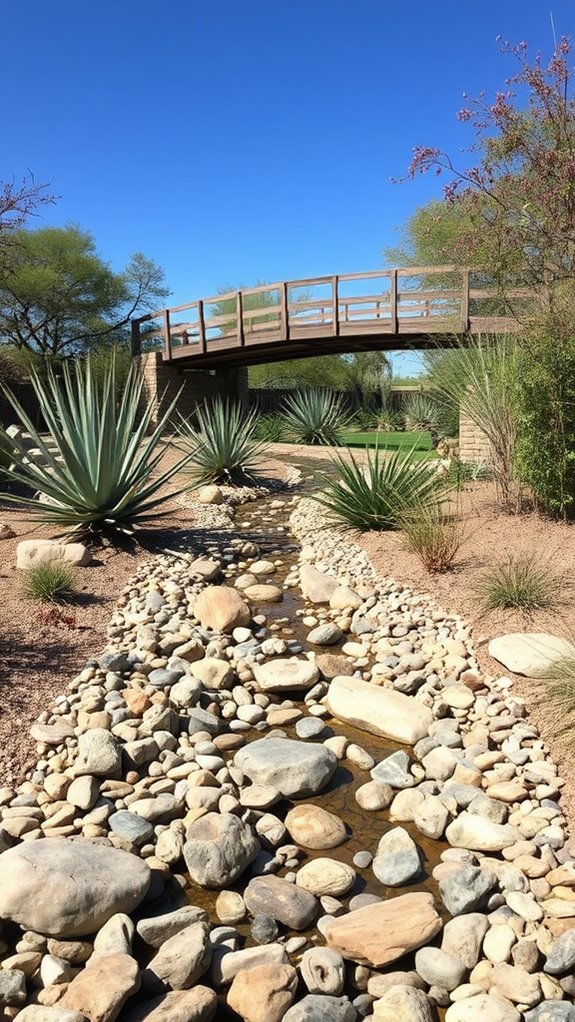
When we get started with the construction of a dry stream bed, we can turn a normal space into a beautiful and effective landscape element.
This new form serves a dual purpose, complementing the appearance of nature, while also acting as a drainage alternative.
Here’s how we can create a beautiful dry stream bed:
- Choose the right location: Identify areas prone to water accumulation.
- Design the path: Create a winding shape for visual interest.
- Select materials: Use rocks and pebbles that complement your garden style.
- Incorporate plants: Add drought-tolerant plants along the edges for color and texture.
- Ensure proper drainage: Slope the stream bed to facilitate water flow during heavy rains.
Using Mulch to Retain Moisture

What is the proper way to use mulch for moisture retention in our landscapes? By selecting organic materials like wood chips or straw, we receive the mulch benefits of soil building and moisture retention.
We use 2-4 inches of this material spread around our plants to provide a barrier that cuts down evaporation and holds moisture in. This helps to not only keep our plants alive during dry periods, but also keeps competing weeds for important resources at bay.
Plus, as the mulch decomposes, it adds nutrients to the soil, creating a healthy ecosystem. Let’s think outside the box here and consider using a colored or textured mulch for visual interest and moisture retention.
Installing Drip Irrigation Systems
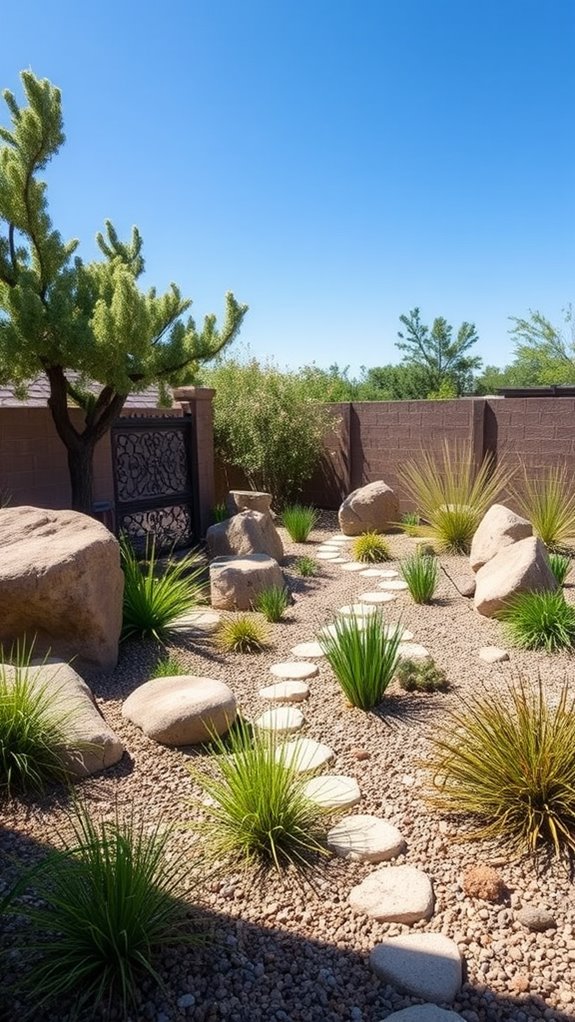
When we are trying to be water efficient in our gardens, drip irrigation systems come to the rescue. This new technology focuses on drip zones, providing water to the roots of the plants and reducing wastage.
Drip irrigation will dramatically improve the sustainability of our garden.
Here are some benefits we can enjoy:
- Targeted watering: Application delivered to avoid over saturation.
- Less evaporation: Water gets to the roots not to the air.
- Lower water bills: Saving by using less.
- Healthier plants: Plants like moisture.
- Less weed growth: Non-target areas receive limited water, discouraging weeds.
Using drip irrigation, we have found a more intelligent and sustainable method of caring for our gardens and improving water use efficiency!
Adding Decorative Gravel Pathways

We may also consider decorative gravel paths to our backyard paradise, which might even help us save water.
Utilizing innovative materials for pathway, like crushed stone or decomposed granite, integrates spaces that are both functional and attractive. We can create decorative designs for these paths, leading our visitors through rich plantings and colorful scenes.
Gravel is also permeable, allowing rainwater to absorb rather than runoff, creating a healthier ecosystem. As we lay these pathways, let’s consider sustainable techniques, like using native stones or recycled materials to minimize our environmental footprint.
The decorative gravel pathways also enhance the beauty of our garden and show our dedication to sustainable solutions.
Building a Xeriscape Vegetable Garden
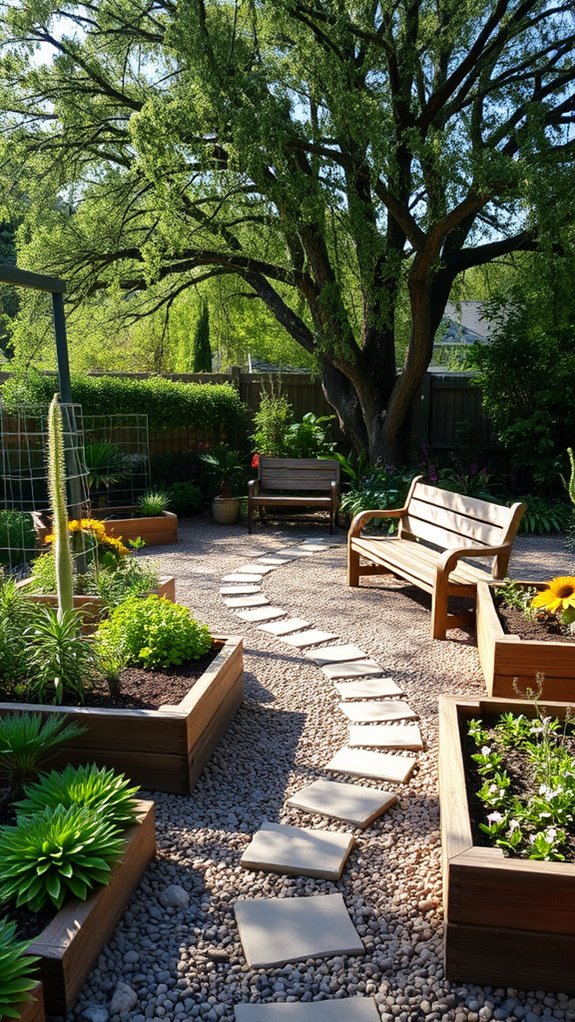
As we may consider vegetable gardens to be thirsty, establishing a xeriscape vegetable garden sets out the idea that with little irrigation, one can still achieve a bountiful harvest.
We can improve soil, and healthy, productive plants, if we farm sustainably.
Here are some key strategies to evaluate:
- Go for drought-resistant crops such as peppers and tomatoes.
- Use companion planting to deter pests and enhance growth.
- Apply mulch for moisture retention and soil temperature moderation.
- Use drip irrigation.
- Use native plants that attract beneficial insects.
These methods will help us conserve water, while developing a lush productive garden that is environmentally friendly.
Let’s innovate and have fun with sustainable gardening!
Implementing Vertical Gardening Techniques

When it comes to vertical gardening, we are introduced to a new tool for optimizing space and improving our xeriscaping.
Vertical space gardening has the ability to turn even the smallest of backyards into a green, productive garden. By using vertical garden structures such as trellises, wall planters, and hanging pots we generate a green environment that is vibrant and grows with little water.
They also provide us with the opportunity to grow a broader range of plants, from herbs to flowering vines, as well as interest in the landscape. Thoughtful plant selection and placement will help us maximize the use of sunlight, and minimize water loss.
Let us unite in vertical gardening as the sustainable solution for our green gardening intentions.
Utilizing Rain Barrels for Water Conservation
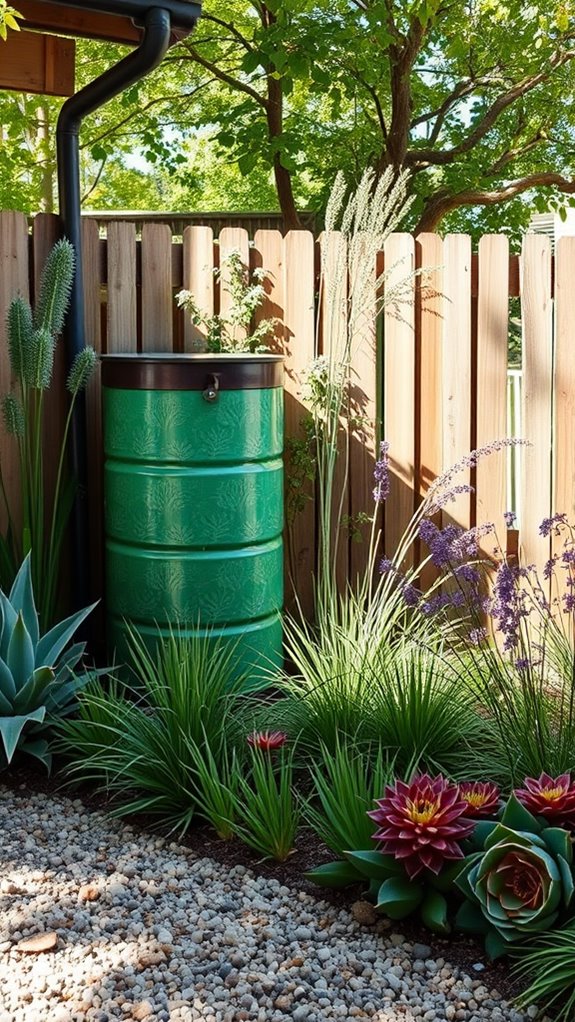
Rain barrels can be used as a sustainable solution to conserving water in our xeriscaped backyards. The use of rainwater harvesting can be used to collect and store rainwater for uses in the garden.
To start, consider some of the advantages of rain barrels:
- Lessens dependence on city water services
- Reduces water bills through intelligent conservation
- Provides a natural irrigation source.
- Promotes biodiversity through native plant support
- Encourages sustainable practices in our community
But we also need to focus on barrel maintenance to ensure clean and safe water storage.
Regular debris checks and proper filtration will protect our rainwater.
Let’s do this together and we can have an ecologically sustainable paradise in our backyards!
Creating a Succulent and Cactus Display

Once we’ve collected rainwater for irrigation, we can take our backyard paradise one step further with a beautiful showcase of succulents and cacti.
In addition to this aesthetic visual interest, by incorporating different types of succulents, Echeveria and Sedum for example, we are also encouraging biodiversity. They are low water use plants that grow well in dry climates, ideal for sustainable landscaping.
Proper cactus care is also important; we ought to ensure their drainage and sun exposure.
Plants that have similar requirements are grouped together in an inventive fashion that requires little upkeep. Using decorative stones and natural mulch can also beautify the area while retaining moisture.
We will nurture a colorful, sustainable garden that celebrates the power of nature.
Designing a Low-Maintenance Flower Bed
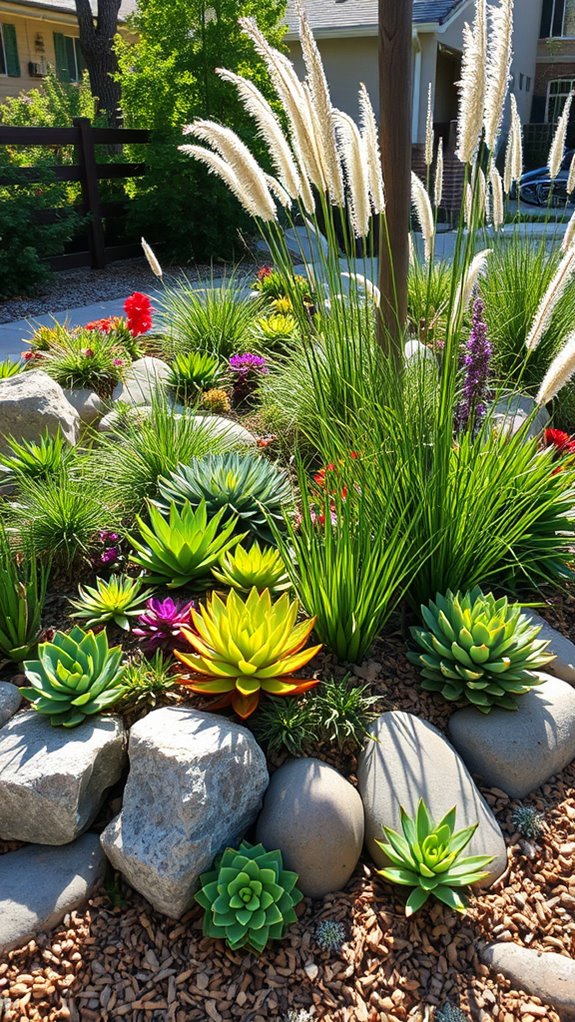
We want our flower beds to be colorful and welcoming, but we also want them to be low maintenance.
Flower bed shapes and color combinations can help us create a beautiful sustainable landscape.
Let’s consider these innovative ideas for a low-maintenance flower bed:
- Native Plants: They require less water and care.
- Perennials: These return year after year, reducing replanting.
- Mulch: It conserves moisture and suppresses weeds.
- Drought-Resistant Varieties: They flourish with minimal irrigation.
- Layering: Create depth by combining heights and colors.
Incorporating Edible Landscaping
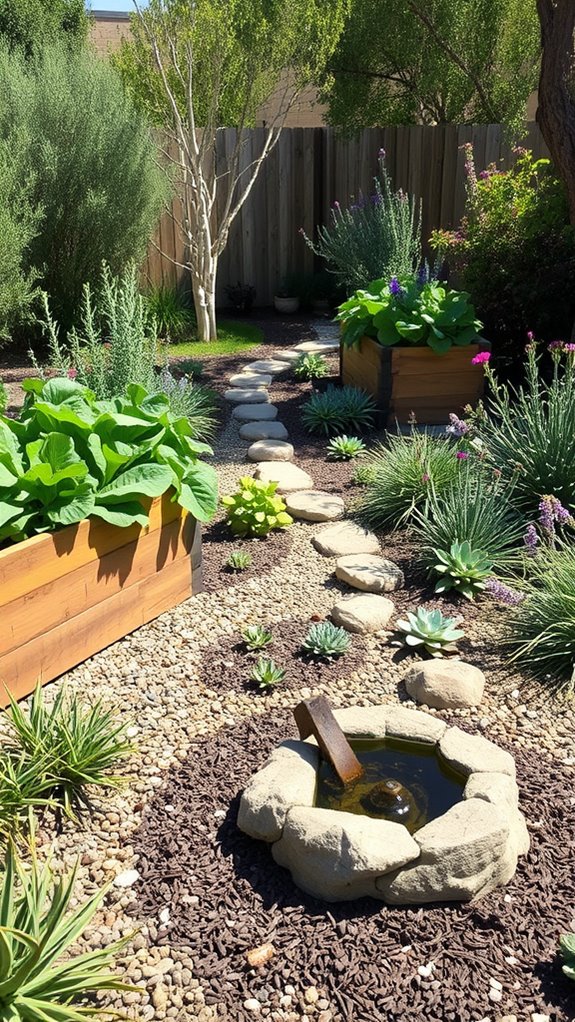
While looking at the potential of edible landscaping, we are learning how the combination of form and function can turn our yards into edible gardens.
Including edible flowers such as nasturtiums and pansies makes our garden even more beautiful and helps lure in beneficial pollinators.
Companion planting is important in this context; e.g. tomatoes and basil should not only be grown in the same area to use space wisely, but also because they grow better and help prevent pest problems.
We can create ecosystems that are diverse, that feed our bodies and the environment.
Herbs such as rosemary and mint are included in our meals, but serve the dual purpose of being natural pests deterrents.
These techniques help us to create not only a sustainable environment, but also a pleasurable environment that is rich in biodiversity.
Planting Ground Cover for Erosion Control
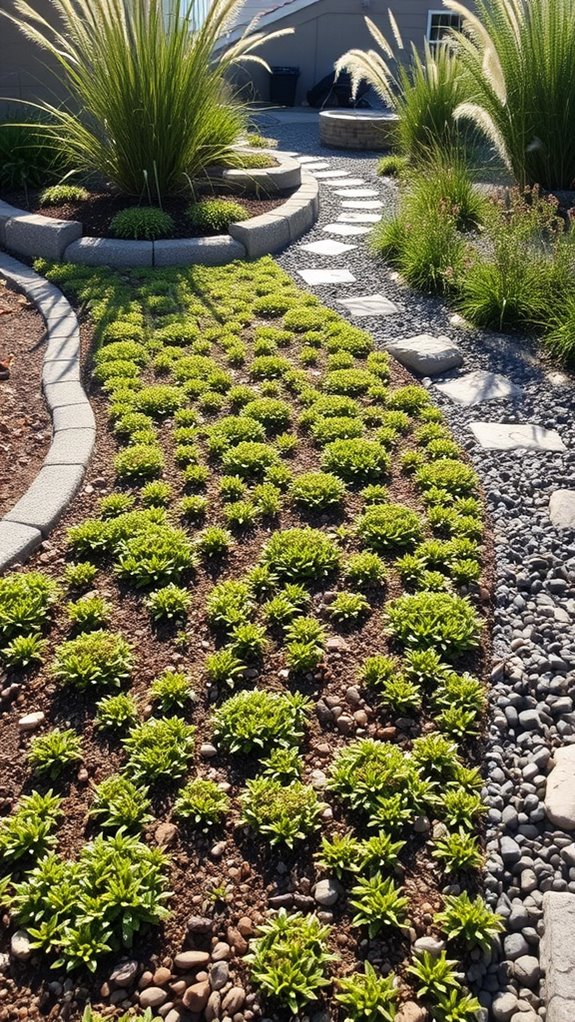
Ground cover plants can be used to fight erosion in our backyards, while adding beauty to the landscape.
They provide a natural erosion barrier and beautify our areas.
Here are some fantastic choices for erosion prevention:
- Creeping Thyme: Does great in the sun and attracts pollinators.
- Sedum: Tolerates drought and rocky terrain.
- Clover: Nitrogen-fixing and produces luxurious green carpets.
- Ajuga: Foliage and spring flowers.
- Liriope: Offers year-round coverage and tolerates foot traffic.
Using Permeable Pavers
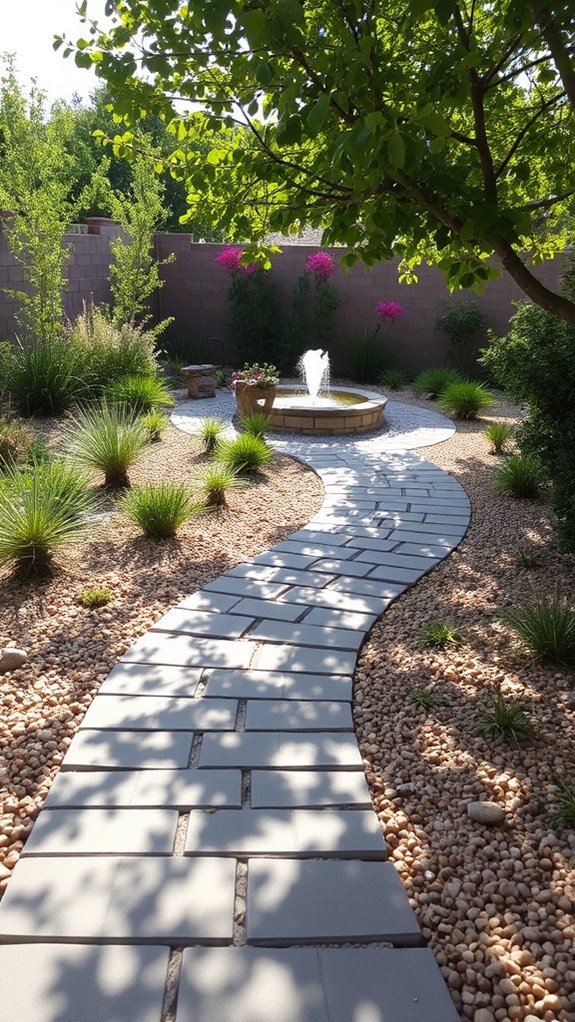
Using permeable pavers in our backyard design gives us a beautiful outdoor space and is a step towards sustainability and proper water management.
These new kinds of pavers let rainwater permeate, recharging the groundwater and decreasing runoff. We’re also benefitting from the advantages of permeable paving in terms of less puddling and no erosion.
Plus, they are available in rustic stones and contemporary tiles, so we can create beautiful patterns. For a green look, we can pair pavers with gravel or native plants.
Permeable pavers are a great functional and attractive option to consider as we redesign our landscaping to help make sure our garden can be sustainable.
Creating Shade With Trees and Shrubs
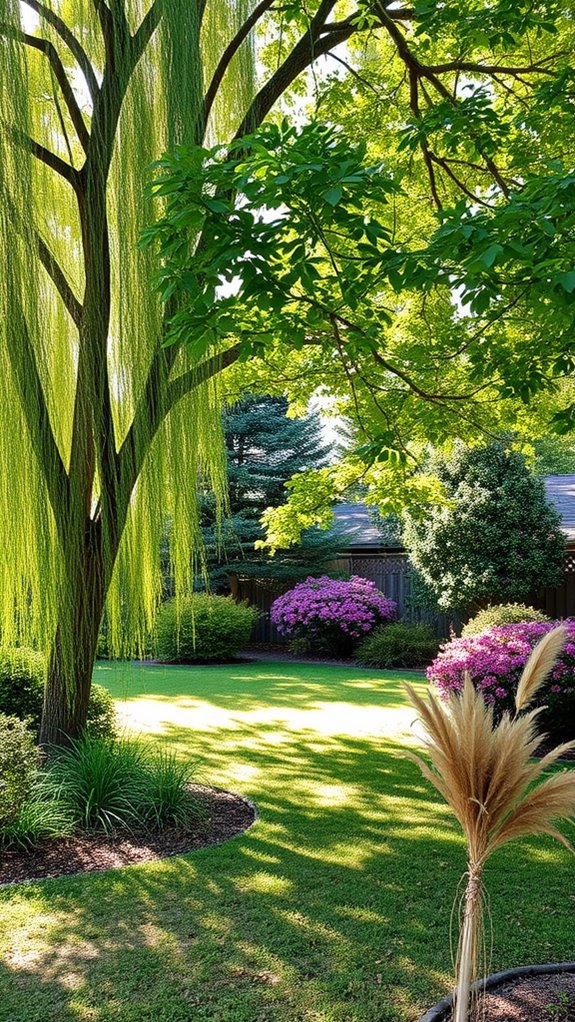
In providing shade by planting trees and shrubs we will experience greater comfort in our outdoor spaces and a greener planet.
Properly sited trees can reduce energy costs and enhance air quality, and properly selected shrubs can offer critical shade structures.
Let’s consider some innovative ideas for our eco-friendly garden:
- Choose native species that do well in our climate.
- Cluster plants for maximum shade.
- Add some verticality, like trellises for climbing plants.
- Select deciduous trees for summer shade and winter solar access.
- Use layered plantings for biodiversity and aesthetics.
Designing a Wildlife-Friendly Habitat
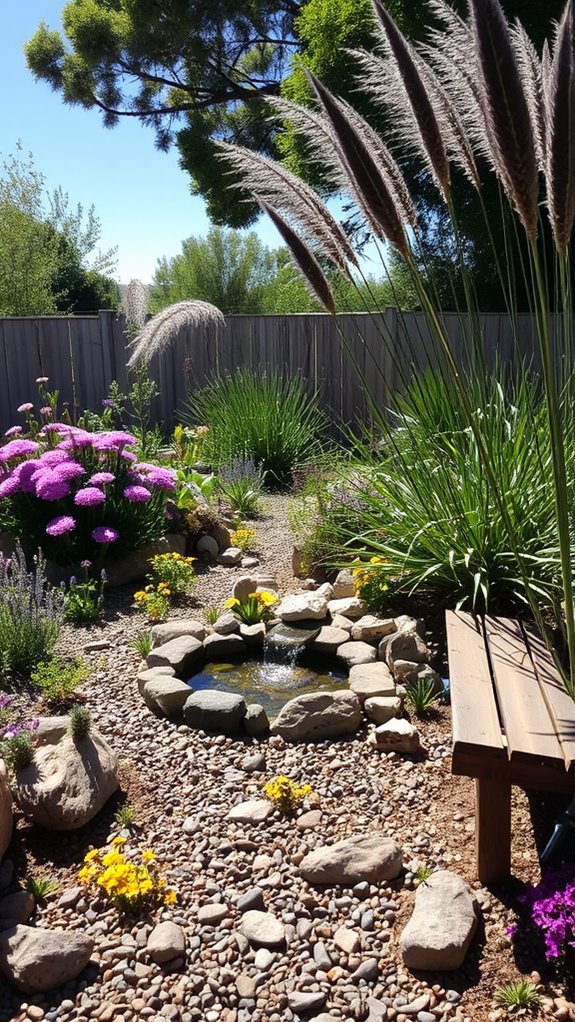
Providing shade with trees and shrubs enhances our outdoor experience, but this also prepares the land for a healthy ecosystem.
We can increase biodiversity and improve habitat connectivity by creating a wildlife friendly habitat. Planting with natives creates a habitat that is rich for pollinators and other desirable organisms.
Wildlife corridors, for example, are important so animals can safely move through our yards to other green spaces.
In addition, strategically located water features (like ponds or bird baths) attract different wildlife, which further beautifies our garden.
We can build a new, modern space that can help meet the fragile balance of nature and inspire us to connect with the natural world just outside our doors, using sustainable materials and practices.
Building Raised Garden Beds
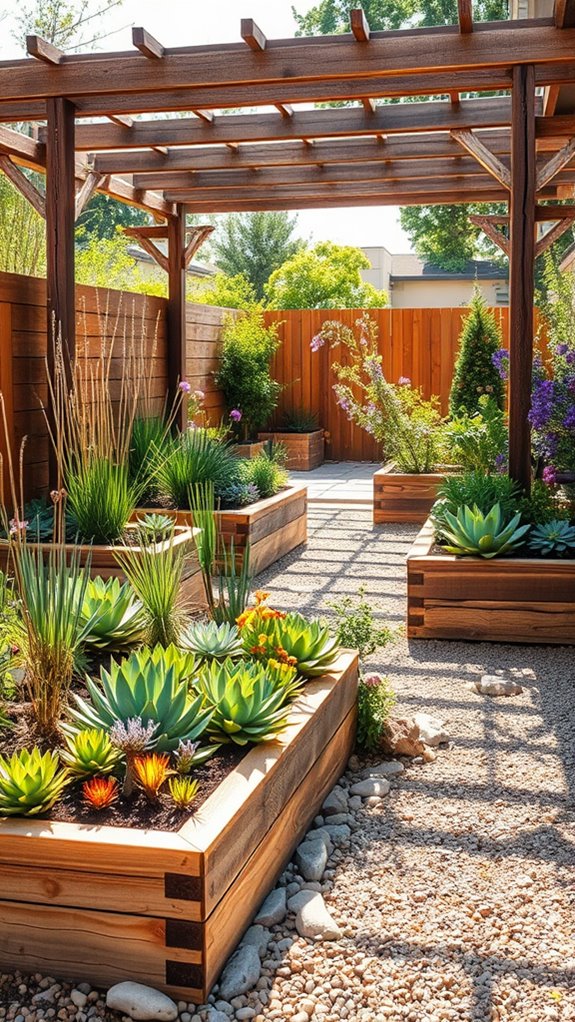
Constructing raised garden beds would make our backyard an oasis of productivity and sustainable gardening. By lifting our plants, we enhance drainage and make maintenance easier.
So let’s look at some of the new ways of making these beds:
- Choose sustainable raised bed materials such as composite materials or reclaimed wood.
- Practice good soil prep, such as layering on organic matter to promote nutrient rich growth.
- Make sure to design beds at a comfortable height to minimize strain during planting and harvesting.
- Use drip irrigation to reduce water loss.
- Consider companion planting to maximize space and create a thriving ecosystem.
Through these methods we can grow a beautiful and ecologically beneficial garden.
Let’s kick off this green adventure!
Adding a Compost Bin
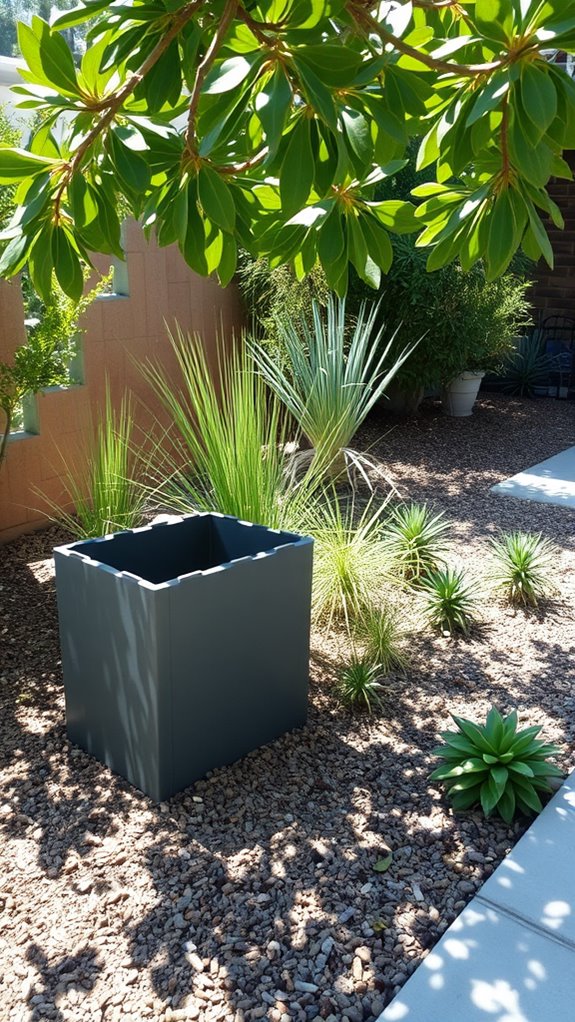
The single most important thing we can do to improve our backyard ecosystem is to have a compost bin. Composting, the way we take advantage of organic waste, by turning it into organic fertilizers that feed our plants and minimize landfill usage.
The benefits of composting aren’t just about better soil; we are also contributing to biodiversity and good soil. By alternating layers of kitchen scraps, yard waste, and browns we create an environment for microorganisms to thrive, which is essential to the decomposition process.
Not only does this innovative concept produce little or no waste, it also gives us the ability to grow a sustainable garden. Let us proudly begin our eco-friendly gardening adventure with composting, for every spade of compost is one in the eye for a healthier planet and a more colorful backyard .
Creating a Zen Garden
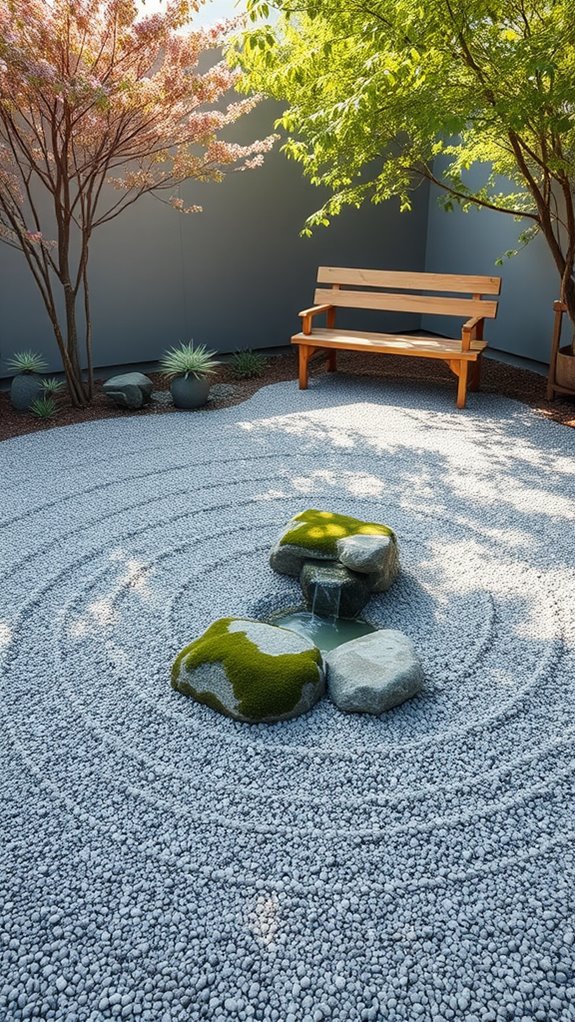
Once we build ourselves a compost bin in the back yard, we can move on to bettering our outdoor space by designing a Zen garden.
The austere room is stripped down, almost monastic, a place to calm the mind.
We will be focusing on things that create a sense of peace but are also sustainable.
- Use raked patterns in gravel or sand.
- Use local stones for a natural look.
- Opt for plants that are drought resistant, such as succulents.
- Incorporate a small seating area for lounging.
- Add bamboo poles or a simple trellis for vertical interest.
Utilizing Water Features for Aesthetic Appeal
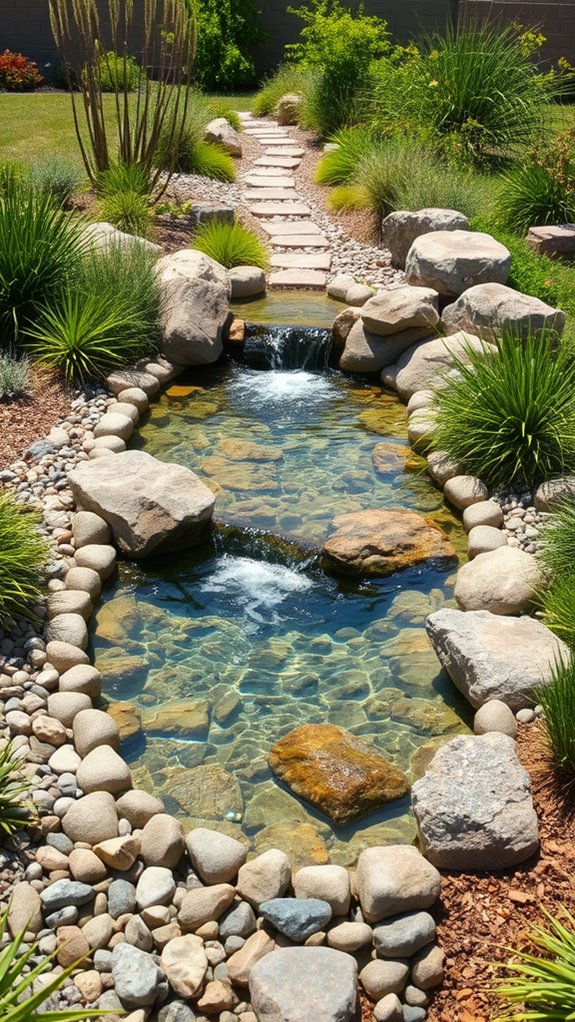
How do we bring up the peace in our backyards, while also being sustainable? Through the integration of new types of water features, we can ensure aesthetic design and ecological services.
Think a rain garden that filters stormwater runoff, or an ordinary pond that provides habitat for wildlife. These features aid in beauty but also in creating a calm environment conducive to relaxation and contemplation.
We might consider recirculating fountains, which waste little water and provide calming sound.
These features can also be enhanced by surrounding native plants, which provide habitat and lessen maintenance.
Incorporating Art and Sculptures
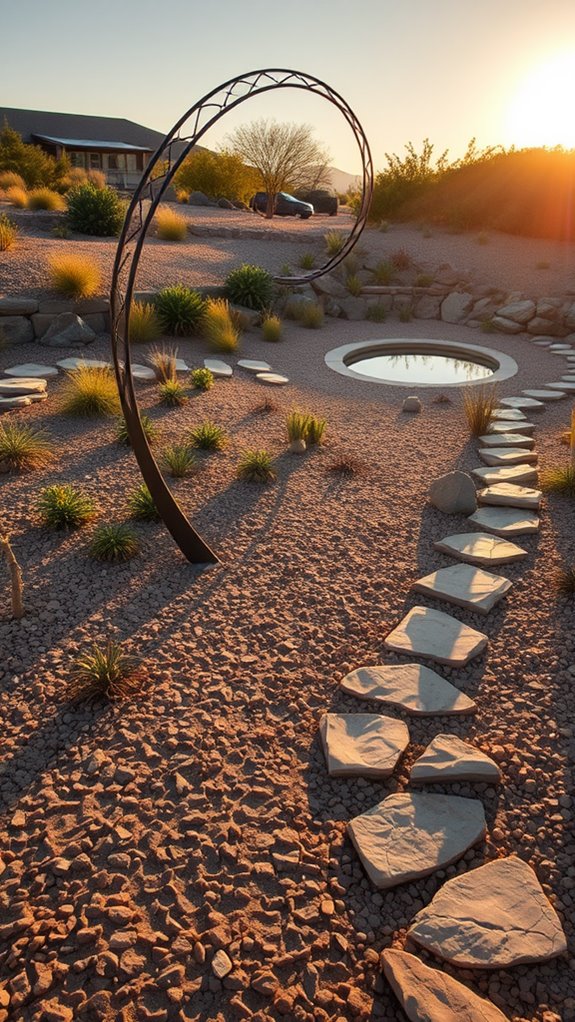
Using art and sculptures in our backyard improves its aesthetics, conveys our sense of style, and encourages sustainability.
We can make beautiful art works that coexist with our environment by selecting sustainable materials for sculpture. These items provide character and promote conversation, melding nature and art.
Here are some innovative ideas for including art in our zeroscaping:
- Weather resistant sculptures made from recycled metals
- Carvings of natural stone integrated into the landscape
- Sunlight filtering through upcycled glass art pieces
- Wooden sculptures that have undergone treatment for sustainability and durability
- Functional art such as benches or tables made from recycled materials
If we choose our pieces well, our garden can become an exhibit of eco-art.
Planting Aromatic Herbs
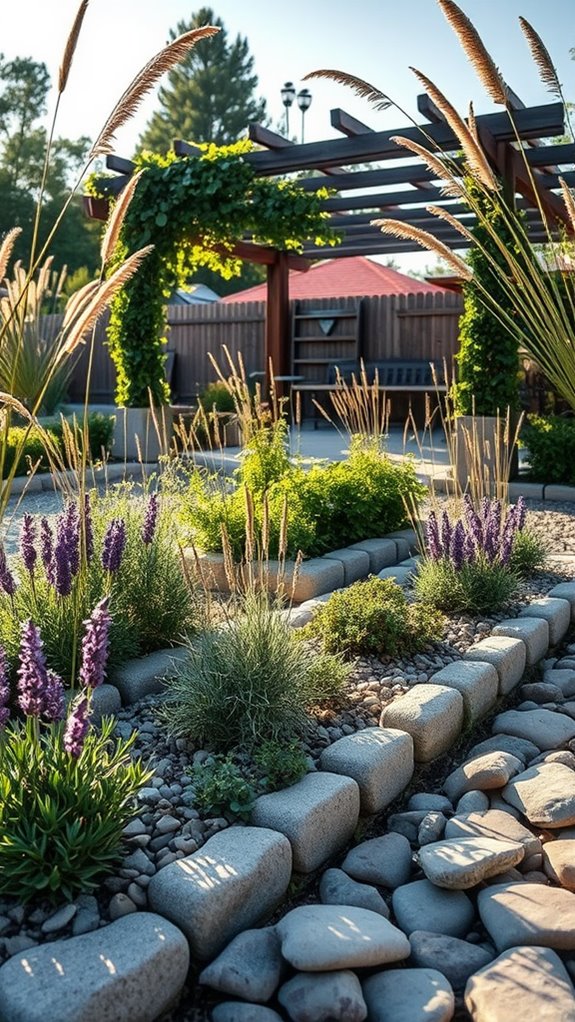
If we consider ways to improve the zeroscape in our backyards, planting aromatic herbs is both a pragmatic and a fun place to start.
These scented types like lavender, basil, and rosemary enhance the beauty of our garden, as well as offer many benefits of herbs. They draw in beneficial insects, they keep pest insects away, and they bring biodiversity, all of which help create a sustainable ecology.
And we can pick their aromatic leaves for cooking, flavoring our dishes with freshness. We can select plants that are drought resistant and conserve water, while also providing us with sensory delight.
These herbs can be incorporated into our design to give an innovative way to interact with nature and improve our outdoor space while maintaining our sustainability efforts.
Let’s get to know these fragrant powerhouses and plant a beautiful, sustainable garden.
Using Containers for Versatile Planting
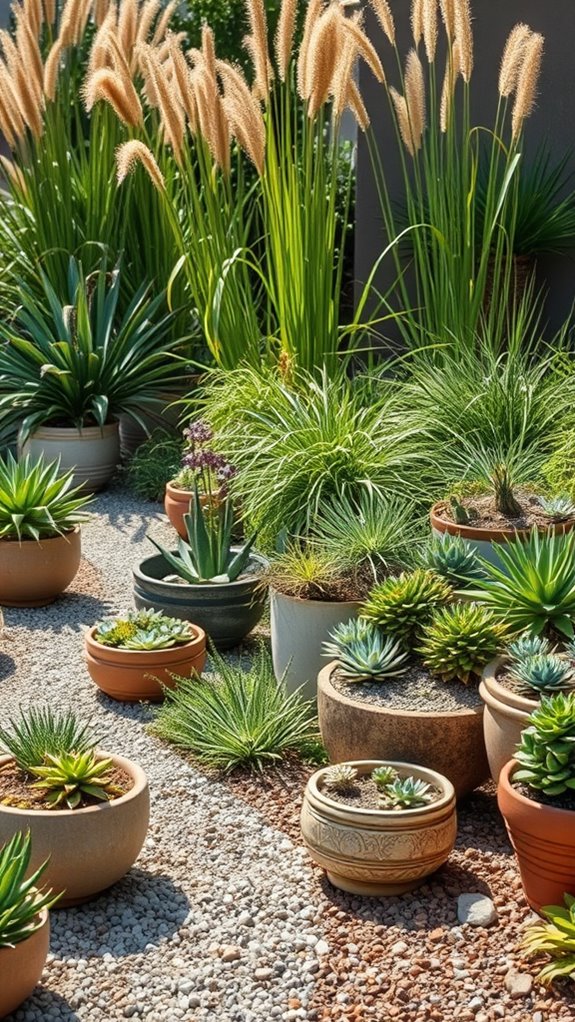
Containers for flexible planting provide endless opportunities in our zeroscaped backyard.
Container gardening allows us to have beautiful arrangements that suit our needs. Because the planters are portable, we can change the arrangement of our garden and keep it interesting.
Here are some innovative ways to utilize containers:
- Combining herbs and flowers to create something aromatic and beautiful.
- Vertical gardens to save space and add depth.
- Using recycled material for an eco-friendly effect.
- Using self-watering planters to save water.
- Seasonally rotating plants to keep our garden vibrant and fresh.
Designing a Fire Pit Area
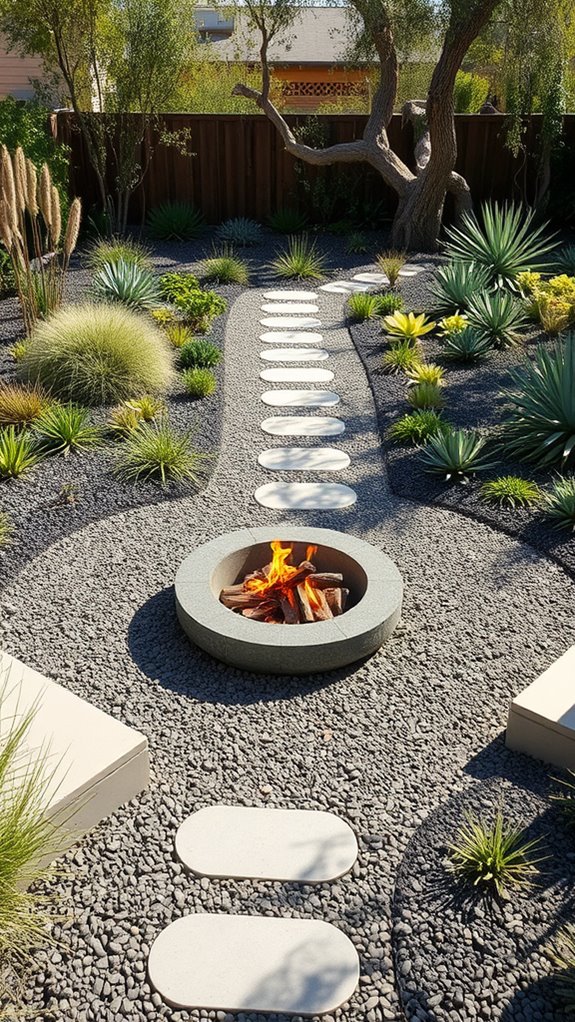
Having looked at container gardening, let’s think about how a fire pit area could complement our backyard zeroscape. A properly designed fire pit can be a good place for gathering and encourages sustainable practices.
Fire pits should be made of fire resistant materials such as stone or metal and should be properly ventilated. The right chairs, even if they are second hand or made of sustainable materials, can make us feel comfortable and welcome.
If we plant drought-tolerant landscaping around the fire pit, not only can we preserve an open zeroscape design, but we can also ensure the space is useful throughout the entire year.
Let’s start getting creative and design a fire pit area that is warm, safe, sustainable and beautiful.
Adding Outdoor Seating With Natural Materials
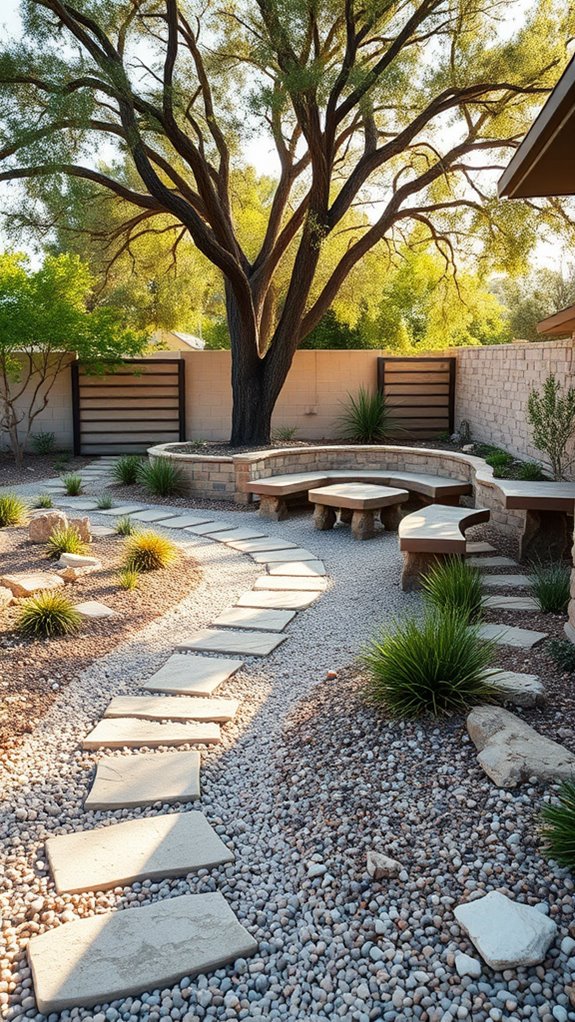
How can we transform our outdoor space into a haven of comfort and sustainability?
Natural material seating can help create cozy spaces for lounging and socializing. Here are some ideas:
- Use bamboo for lightweight, eco-friendly furniture.
- Make tables out of rough-hewn natural wood that fit in with nature.
- Design stone benches for durability and a natural aesthetic.
- For comfort and style, add outdoor cushions made from recycled materials.
- Consider tree stumps and hammock spots as interesting and useful seating.
Implementing Seasonal Color With Hardy Plants

Although seasonal color seems like a maintenance-intensive feature, with the right plants it can be low-maintenance and still provide a rainbow of colors. Perennial plants can guarantee color in the garden year-round if we choose tough varieties.
These hardy plants can grow in many different climates, and provide seasonal pops of color that draw the eye and beautify our outdoor spaces.
Think of a palette that moves from the bright yellows of coreopsis in spring to the dark reds of sedum in fall. These plants not only consume less water, but help support local wildlife.
Creating a Biodiversity-Friendly Garden
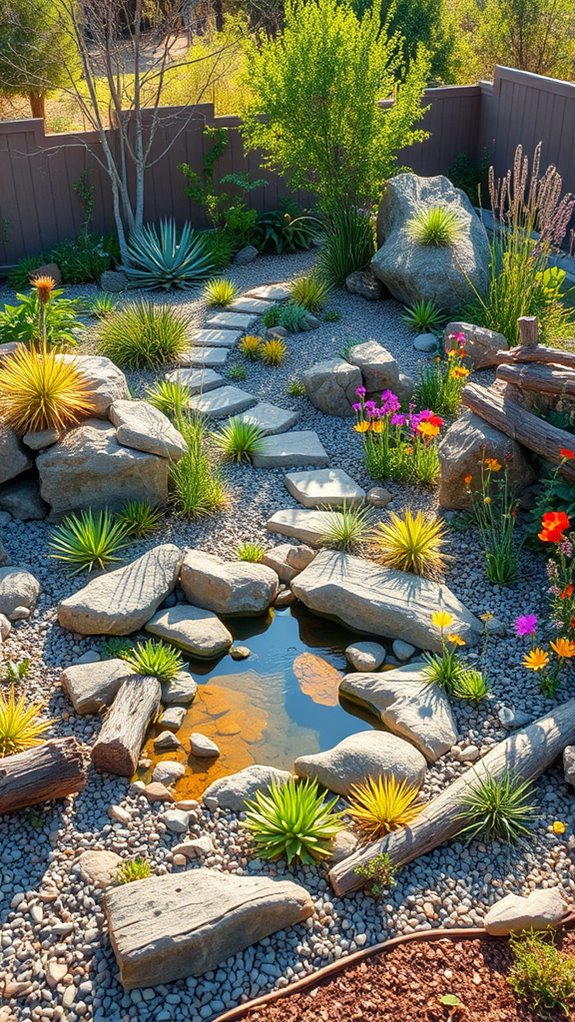
In our efforts to create a biodiversity garden, planting a wide assortment of native plants is important to attract good insects, birds, and other wildlife.
Pollinator gardens and wildlife corridors designed to help restore habitat and support native pollinators is one way we can help. Let us restore balance to our ecosystems by organic gardening and practicing sustainability that increases the health of the soil and plant diversity.
Here are some innovative ideas to inspire us:
- Plant native flowers that bloom at different times to extend food sources.
- Provide water features that will benefit a diversity of wildlife.
- Install insect hotels for beneficial insects.
- Apply mulch for moisture retention and soil improvement.
- Provide space for composting to fertilize our garden organically.
Let’s grow a flourishing ecosystem together!

